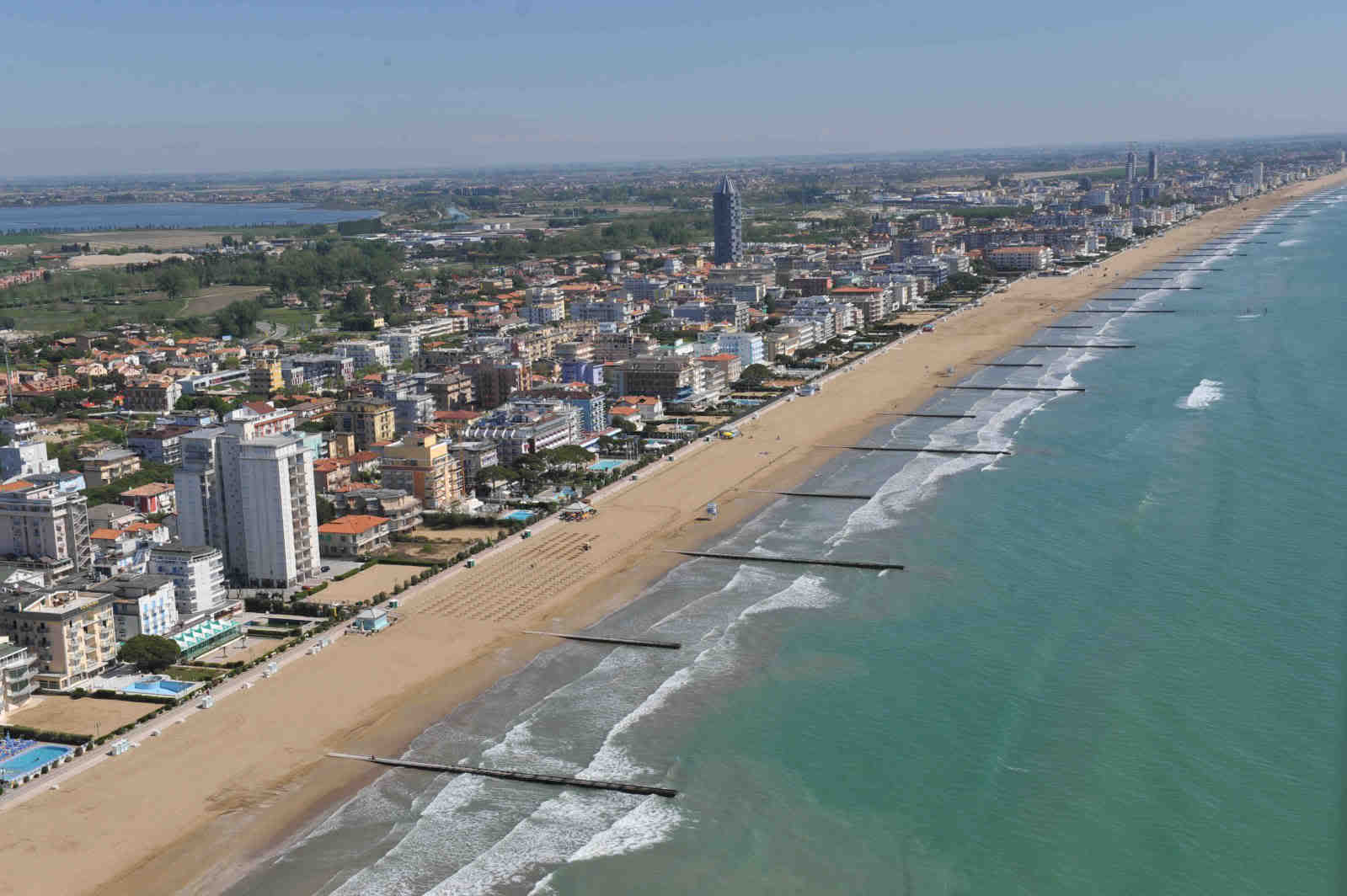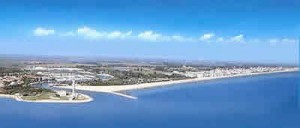
Jesolo
Lido di Jesolo a place to vacation and turism at a few kilometers from the enchanting Venice, with its 15 kilometres of fine dolomite sand, accomodates every year over 10 millions of tourists (including those who overnight and those who stay for the day) who spend their holidays making escursions in the greenery of the pinewood and in the encahting valleys of the lagoon, who entertain themselves in the modern discos, in the squares with hundreds of shows of every kind, the coloured fun fairs and above all Via Bafile, the longest pedestrian way in Europe.
 HISTORY
The first information about Jesolo as touristic centre go back to the end of the 19th Century when the first bathing establishment was opened on the beach in front of Piazza Marconi.
After the Great War the touristic activity grew quickly and villas, holiday camps and hotels were build. In 1937 there were in Jesolo 47 licences of rooms for rent, 24 public facilities and 4 season hotels. After three years the rooms for rent were 11, the apartments were 57, in addition to 2 inns, 1 restaurants, 3 boarding-houses and 6 hotels. In 1938 the tourists were 10.780. In 1939 the rooms for rent were 20, the apartments and villas were 76, the inns were 5,boarding-houses 3 and hotels 8; but it is after World War II that Jesolo found its way in tourism. The lido (beach) of Jesolo drew the attention of Venetians and Lombards who had capitals to invest in the new development of tourism, and built hotels, apartments, camp-sites, wet docks and villas, but also shops, restaurants and sports-facilities.
Two millenniums history are behind this 'precision device' as we can call Jesolo within the tourism economy of the lowerVeneto. While this capital of fun, fashion and trends is more and more turned to the 'immediate use', it is another atmosphere that you can breathe in the near hinterland.
The 'Street of the Ancient Walls', starting from Jesolo centre is in fact a fascinating route along which all traces of a noble and glorious past reveal themselves and all the latest efforts aim to create a real archeological itinerary in order to enhance an aspect of this area which has remained almost unknown for a long time.
Once upon a time there was a village called Equilio, later Cavazuccherina, today Jesolo and not far a desert beach wet by the waters of the Adriatico Sea. Equilo, from the latin word equus=town of horses,and according to transcriptions also Equilio, Esquilio, Esulo, Lesulo, Jexollo and today Jesolo has its roots in the times of the Roman Empire as vicus (= village), on an island next to the mouth of the Piave: it was at the time one of the many places used by merchants in their journeys inside the lagoon, above all in winter, sheltered from winds (the Bora) and storms, on the way from Ravenna, port where the grain of the 9th Augustean Region called Aemilia was embarked, to the great town-fortress Aquileia, rampart of the Eastern Roman border.
Exposed to the continuous barbaric invasions (from the 5th Century on ), a part of the helpless inhabitants of Altino, Oderzo and of the areas around Treviso and Belluno, in their escape, following the river Piave, chose Jesolo as last refuge.
With the fall of the Roman Empire, Jesolo and the other towns of the Venetian estuary (Rialto, Murano, Burano, Torcello, Malamocco, San Pietro in Volta, Chioggia, Brondolo, Fossone, Eraclea, Fine, Caorle, Grado and Cavarzere), remained without a political direction, they formed a congregation and created their own autonomous government by electing in 697 as head of the government Paoluccio Anafesto, the unforgettable first Doge.
Together with wars and invasions the region was hit by environmental disasters, provoked by the Piave which changed his course several times in the past. Though its economic power was reduced and slow because of the fights against Eraclea, by the barbaric invasions, Jesolo grew and strenghtened its trades with in-land towns and with the East by sailing on the sea, exporting fish, salt (there were 32 salt-mines) and manufactured products and imported wood, spices and fabrics: its port frequented by travellers and merchants who stopped for the precious wares brought by the sailors of Jesolo. In 1000 the Doge Orseolo left from the port of Jesolo with its fleet steering towards the Istrian and Dalmatian costs, defeated the pirates who infested the upper Adriatico and submitted them.
After a couple of centuries of prosperity there came a decay. Only around the half of the 15th Century, the Serenissima was interested in developping the trade using the waterways in Friuli and began the works, lead by Liberal from Oderzo, in 1440 of escavation of a canal (no more existing), which had to join The Piave to the Revedoli, making it possible for crafts to sail from Venice to Caorle or Grado, without going out at sea. The opening of the canal (spring of 1441), favoured the birth of stores and houses for workers or keepers as well as nobles who invested their fortunes on the territory. At the end of the 15th Century the nobles Gradenigo, Malipiero, Soranzo and others began to bonificate the lands and easied the settlement of many colons. On the 3rd of January 1495 the Patriarch of Venice, Tommaso Donà, accepted the requests of the nobles and workers and estabished the Parish of San Giovanni Battista, the most ancient in the Basso Piave.
After a few years the upkeeping of the canal was given to Alvise Zucharin and his heirs (November 20, 1499) and that surname gave slowly a new name to the old Equilio-Jesolo, which would become Cava (canal) Zucharina (from the name of the family Zucharin), reported in various manners in the venetian documents: Cava Zuccherina, Cavazucharina, Cavazuccherina. The name was maintained by the town and by the Commune (established by Napoleon on the 22nd of December 1807) until the 28th of August 1930, when endly the king Vittorio Emanuele III allowed the re-use of the historical name Jesolo.
HISTORY
The first information about Jesolo as touristic centre go back to the end of the 19th Century when the first bathing establishment was opened on the beach in front of Piazza Marconi.
After the Great War the touristic activity grew quickly and villas, holiday camps and hotels were build. In 1937 there were in Jesolo 47 licences of rooms for rent, 24 public facilities and 4 season hotels. After three years the rooms for rent were 11, the apartments were 57, in addition to 2 inns, 1 restaurants, 3 boarding-houses and 6 hotels. In 1938 the tourists were 10.780. In 1939 the rooms for rent were 20, the apartments and villas were 76, the inns were 5,boarding-houses 3 and hotels 8; but it is after World War II that Jesolo found its way in tourism. The lido (beach) of Jesolo drew the attention of Venetians and Lombards who had capitals to invest in the new development of tourism, and built hotels, apartments, camp-sites, wet docks and villas, but also shops, restaurants and sports-facilities.
Two millenniums history are behind this 'precision device' as we can call Jesolo within the tourism economy of the lowerVeneto. While this capital of fun, fashion and trends is more and more turned to the 'immediate use', it is another atmosphere that you can breathe in the near hinterland.
The 'Street of the Ancient Walls', starting from Jesolo centre is in fact a fascinating route along which all traces of a noble and glorious past reveal themselves and all the latest efforts aim to create a real archeological itinerary in order to enhance an aspect of this area which has remained almost unknown for a long time.
Once upon a time there was a village called Equilio, later Cavazuccherina, today Jesolo and not far a desert beach wet by the waters of the Adriatico Sea. Equilo, from the latin word equus=town of horses,and according to transcriptions also Equilio, Esquilio, Esulo, Lesulo, Jexollo and today Jesolo has its roots in the times of the Roman Empire as vicus (= village), on an island next to the mouth of the Piave: it was at the time one of the many places used by merchants in their journeys inside the lagoon, above all in winter, sheltered from winds (the Bora) and storms, on the way from Ravenna, port where the grain of the 9th Augustean Region called Aemilia was embarked, to the great town-fortress Aquileia, rampart of the Eastern Roman border.
Exposed to the continuous barbaric invasions (from the 5th Century on ), a part of the helpless inhabitants of Altino, Oderzo and of the areas around Treviso and Belluno, in their escape, following the river Piave, chose Jesolo as last refuge.
With the fall of the Roman Empire, Jesolo and the other towns of the Venetian estuary (Rialto, Murano, Burano, Torcello, Malamocco, San Pietro in Volta, Chioggia, Brondolo, Fossone, Eraclea, Fine, Caorle, Grado and Cavarzere), remained without a political direction, they formed a congregation and created their own autonomous government by electing in 697 as head of the government Paoluccio Anafesto, the unforgettable first Doge.
Together with wars and invasions the region was hit by environmental disasters, provoked by the Piave which changed his course several times in the past. Though its economic power was reduced and slow because of the fights against Eraclea, by the barbaric invasions, Jesolo grew and strenghtened its trades with in-land towns and with the East by sailing on the sea, exporting fish, salt (there were 32 salt-mines) and manufactured products and imported wood, spices and fabrics: its port frequented by travellers and merchants who stopped for the precious wares brought by the sailors of Jesolo. In 1000 the Doge Orseolo left from the port of Jesolo with its fleet steering towards the Istrian and Dalmatian costs, defeated the pirates who infested the upper Adriatico and submitted them.
After a couple of centuries of prosperity there came a decay. Only around the half of the 15th Century, the Serenissima was interested in developping the trade using the waterways in Friuli and began the works, lead by Liberal from Oderzo, in 1440 of escavation of a canal (no more existing), which had to join The Piave to the Revedoli, making it possible for crafts to sail from Venice to Caorle or Grado, without going out at sea. The opening of the canal (spring of 1441), favoured the birth of stores and houses for workers or keepers as well as nobles who invested their fortunes on the territory. At the end of the 15th Century the nobles Gradenigo, Malipiero, Soranzo and others began to bonificate the lands and easied the settlement of many colons. On the 3rd of January 1495 the Patriarch of Venice, Tommaso Donà, accepted the requests of the nobles and workers and estabished the Parish of San Giovanni Battista, the most ancient in the Basso Piave.
After a few years the upkeeping of the canal was given to Alvise Zucharin and his heirs (November 20, 1499) and that surname gave slowly a new name to the old Equilio-Jesolo, which would become Cava (canal) Zucharina (from the name of the family Zucharin), reported in various manners in the venetian documents: Cava Zuccherina, Cavazucharina, Cavazuccherina. The name was maintained by the town and by the Commune (established by Napoleon on the 22nd of December 1807) until the 28th of August 1930, when endly the king Vittorio Emanuele III allowed the re-use of the historical name Jesolo.